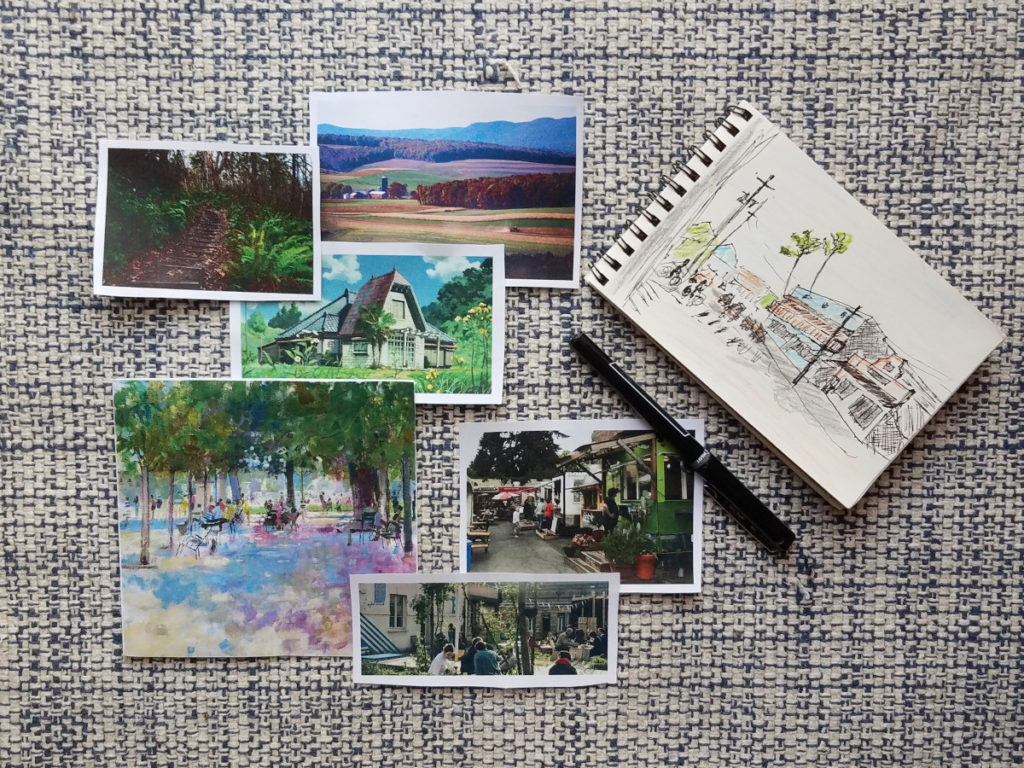Imagine the best place you know. A place that made you feel alive— like all was well. A place that felt completely comfortable. It could be somewhere you’ve visited, or if you’re lucky somewhere you lived. Maybe it’s an imaginary place. It could be a neighborhood or a chair by a nice window. Maybe it was a street where people waved hello, or busy waterfront walk in the evening, or a quiet porch in the afternoon. Close your eyes and try to feel what it was like to be there.
What made that place so good? How can the places you live, work, or hang out be like that?
Here are some books I’ve found about making wonderful, live-enhancing places.
These books are generally about lively, humble places where everyday life happens. Well beyond design and decoration, these books focus on how physical characteristics, life activities, communities, and the natural environment can interact and work together to create healthy places. They also tend to highlight grass-roots approaches to placemaking, rather than processes driven by developers, governments, or architects, though each of those groups can help or hinder the work.
From this list, the books by Christopher Alexander are my favorites. One of these books is always on my active reading pile and the bookmarks make their way from beginning to end, then loop right back to the beginning. I love his vision of a living and lively world of human habitation and his methods are both immediately applicable and endlessly profound.
Book list
442173
2L6HHY89
items
1
turabian-author-date
0
author
asc
1
1
1
title
1688
https://www.restlessdevice.com/wp-content/plugins/zotpress/
%7B%22status%22%3A%22success%22%2C%22updateneeded%22%3Afalse%2C%22instance%22%3A%22zotpress-cb0f5ffaae1ffbd7409643a65abffdc4%22%2C%22meta%22%3A%7B%22request_last%22%3A0%2C%22request_next%22%3A0%2C%22used_cache%22%3Atrue%7D%2C%22data%22%3A%5B%7B%22key%22%3A%22E46BIX9H%22%2C%22library%22%3A%7B%22id%22%3A442173%7D%2C%22meta%22%3A%7B%22creatorSummary%22%3A%22Alexander%22%2C%22parsedDate%22%3A%222002%22%2C%22numChildren%22%3A1%7D%2C%22bib%22%3A%22%3Cdiv%20class%3D%5C%22csl-bib-body%5C%22%20style%3D%5C%22line-height%3A%201.35%3B%20padding-left%3A%201em%3B%20text-indent%3A-1em%3B%5C%22%3E%5Cn%20%3Cdiv%20class%3D%5C%22csl-entry%5C%22%3EAlexander%2C%20Christopher.%202002.%20%3Ci%3E%3Ca%20target%3D%27_blank%27%20href%3D%27http%3A%5C%2F%5C%2Fwww.worldcat.org%5C%2Foclc%5C%2F936976903%27%3EThe%20nature%20of%20order%3A%20an%20essay%20on%20the%20art%20of%20building%20and%20the%20nature%20of%20the%20universe%3C%5C%2Fa%3E%3C%5C%2Fi%3E.%20Center%20for%20Environmental%20Structure%20Series%5Cu202f%3B%20v.%209-12.%20Berkeley%2C%20Calif.%3A%20Center%20for%20Environmental%20Structure.%20%20%3Ca%20title%3D%27Cite%20in%20RIS%20Format%27%20class%3D%27zp-CiteRIS%27%20href%3D%27https%3A%5C%2F%5C%2Fwww.restlessdevice.com%5C%2Fwp-content%5C%2Fplugins%5C%2Fzotpress%5C%2Flib%5C%2Frequest%5C%2Frequest.cite.php%3Fapi_user_id%3D442173%26amp%3Bitem_key%3DE46BIX9H%27%3ECite%3C%5C%2Fa%3E%20%3C%5C%2Fdiv%3E%5Cn%3C%5C%2Fdiv%3E%22%2C%22data%22%3A%7B%22itemType%22%3A%22book%22%2C%22title%22%3A%22The%20nature%20of%20order%3A%20an%20essay%20on%20the%20art%20of%20building%20and%20the%20nature%20of%20the%20universe%22%2C%22creators%22%3A%5B%7B%22creatorType%22%3A%22author%22%2C%22firstName%22%3A%22Christopher%22%2C%22lastName%22%3A%22Alexander%22%7D%5D%2C%22abstractNote%22%3A%22%5C%22Here%20is%20acclaimed%20architect%20Christopher%20Alexander%27s%20four-volume%20masterwork%3B%20the%20result%20of%2027%20years%20of%20research%20and%20a%20lifetime%20of%20profoundly%20original%20thinking.%20Consider%20three%20vital%20perspectives%20on%20our%20world%3A%20a%20scientific%20perspective%3B%20a%20perspective%20based%20on%20beauty%20and%20grace%3B%20a%20commonsense%20perspective%20based%20on%20our%20intuitions%20about%20everyday%20life.%20Neither%20scientists%2C%20nor%20mystics%2C%20nor%20architects%2C%20nor%20politicians%20have%20so%20far%20found%20a%20single%20view%20of%20the%20world%20in%20which%20the%20three%20are%20united.%20This%20groundbreaking%20work%20allows%20us%20to%20form%20on%20picture%20of%20the%20world%20in%20which%20all%20three%20perspectives%20are%20interlaces.%20It%20opens%20the%20door%20to%2021st-century%20science%20and%20cosmology.%5C%22--From%20dust%20jacket.%22%2C%22date%22%3A%222002%22%2C%22language%22%3A%22eng%22%2C%22ISBN%22%3A%22978-0-9726529-1-9%22%2C%22url%22%3A%22http%3A%5C%2F%5C%2Fwww.worldcat.org%5C%2Foclc%5C%2F936976903%22%2C%22collections%22%3A%5B%22MSCX8IX7%22%2C%222L6HHY89%22%2C%22XDLIRZHK%22%5D%2C%22dateModified%22%3A%222022-01-22T23%3A56%3A29Z%22%7D%7D%2C%7B%22key%22%3A%22BCK2S6MR%22%2C%22library%22%3A%7B%22id%22%3A442173%7D%2C%22meta%22%3A%7B%22creatorSummary%22%3A%22Alexander%22%2C%22parsedDate%22%3A%221979%22%2C%22numChildren%22%3A1%7D%2C%22bib%22%3A%22%3Cdiv%20class%3D%5C%22csl-bib-body%5C%22%20style%3D%5C%22line-height%3A%201.35%3B%20padding-left%3A%201em%3B%20text-indent%3A-1em%3B%5C%22%3E%5Cn%20%3Cdiv%20class%3D%5C%22csl-entry%5C%22%3EAlexander%2C%20Christopher.%201979.%20%3Ci%3E%3Ca%20target%3D%27_blank%27%20href%3D%27http%3A%5C%2F%5C%2Fwww.worldcat.org%5C%2Foclc%5C%2F249321909%27%3EThe%20timeless%20way%20of%20building%3C%5C%2Fa%3E%3C%5C%2Fi%3E.%20New%20York%3A%20Oxford%20University%20Press.%20%20%3Ca%20title%3D%27Cite%20in%20RIS%20Format%27%20class%3D%27zp-CiteRIS%27%20href%3D%27https%3A%5C%2F%5C%2Fwww.restlessdevice.com%5C%2Fwp-content%5C%2Fplugins%5C%2Fzotpress%5C%2Flib%5C%2Frequest%5C%2Frequest.cite.php%3Fapi_user_id%3D442173%26amp%3Bitem_key%3DBCK2S6MR%27%3ECite%3C%5C%2Fa%3E%20%3C%5C%2Fdiv%3E%5Cn%3C%5C%2Fdiv%3E%22%2C%22data%22%3A%7B%22itemType%22%3A%22book%22%2C%22title%22%3A%22The%20timeless%20way%20of%20building%22%2C%22creators%22%3A%5B%7B%22creatorType%22%3A%22author%22%2C%22firstName%22%3A%22Christopher%22%2C%22lastName%22%3A%22Alexander%22%7D%5D%2C%22abstractNote%22%3A%22This%20introductory%20volume%20to%20Alexander%27s%20other%20works%2C%20A%20Pattern%20of%20Language%20and%20The%20Oregon%20Experiment%2C%20explains%20concepts%20fundamental%20to%20his%20original%20approaches%20to%20the%20theory%20and%20application%20of%20architecture.%22%2C%22date%22%3A%221979%22%2C%22language%22%3A%22eng%22%2C%22ISBN%22%3A%22%22%2C%22url%22%3A%22http%3A%5C%2F%5C%2Fwww.worldcat.org%5C%2Foclc%5C%2F249321909%22%2C%22collections%22%3A%5B%22MSCX8IX7%22%2C%222L6HHY89%22%2C%22XDLIRZHK%22%5D%2C%22dateModified%22%3A%222022-01-24T14%3A18%3A40Z%22%7D%7D%2C%7B%22key%22%3A%22GCYKYXS3%22%2C%22library%22%3A%7B%22id%22%3A442173%7D%2C%22meta%22%3A%7B%22creatorSummary%22%3A%22Alexander%22%2C%22parsedDate%22%3A%221977%22%2C%22numChildren%22%3A1%7D%2C%22bib%22%3A%22%3Cdiv%20class%3D%5C%22csl-bib-body%5C%22%20style%3D%5C%22line-height%3A%201.35%3B%20padding-left%3A%201em%3B%20text-indent%3A-1em%3B%5C%22%3E%5Cn%20%3Cdiv%20class%3D%5C%22csl-entry%5C%22%3EAlexander%2C%20Christopher.%201977.%20%3Ci%3E%3Ca%20target%3D%27_blank%27%20href%3D%27http%3A%5C%2F%5C%2Fwww.worldcat.org%5C%2Foclc%5C%2F961298119%27%3EA%20pattern%20language%3A%20towns%2C%20buildings%2C%20construction%3C%5C%2Fa%3E%3C%5C%2Fi%3E.%20New%20York%3A%20Oxford%20University%20Press.%20%20%3Ca%20title%3D%27Cite%20in%20RIS%20Format%27%20class%3D%27zp-CiteRIS%27%20href%3D%27https%3A%5C%2F%5C%2Fwww.restlessdevice.com%5C%2Fwp-content%5C%2Fplugins%5C%2Fzotpress%5C%2Flib%5C%2Frequest%5C%2Frequest.cite.php%3Fapi_user_id%3D442173%26amp%3Bitem_key%3DGCYKYXS3%27%3ECite%3C%5C%2Fa%3E%20%3C%5C%2Fdiv%3E%5Cn%3C%5C%2Fdiv%3E%22%2C%22data%22%3A%7B%22itemType%22%3A%22book%22%2C%22title%22%3A%22A%20pattern%20language%3A%20towns%2C%20buildings%2C%20construction%22%2C%22creators%22%3A%5B%7B%22creatorType%22%3A%22author%22%2C%22firstName%22%3A%22Christopher%22%2C%22lastName%22%3A%22Alexander%22%7D%2C%7B%22creatorType%22%3A%22contributor%22%2C%22firstName%22%3A%22Sara%22%2C%22lastName%22%3A%22Ishikawa%22%7D%2C%7B%22creatorType%22%3A%22contributor%22%2C%22firstName%22%3A%22Murray%22%2C%22lastName%22%3A%22Silverstein%22%7D%2C%7B%22creatorType%22%3A%22contributor%22%2C%22firstName%22%3A%22Sara%22%2C%22lastName%22%3A%22Ishikawa%22%7D%2C%7B%22creatorType%22%3A%22contributor%22%2C%22firstName%22%3A%22Murray%22%2C%22lastName%22%3A%22Silverstein%22%7D%2C%7B%22creatorType%22%3A%22contributor%22%2C%22name%22%3A%22Center%20for%20Environmental%20Structure%22%7D%5D%2C%22abstractNote%22%3A%22Review%3A%20%5C%22At%20the%20core%20of%20the%20book%20is%20the%20point%20that%20in%20designing%20their%20environments%20people%20always%20rely%20on%20certain%20%27languages%27%2C%20which%2C%20like%20the%20languages%20we%20speak%2C%20allow%20them%20to%20articulate%20and%20communicate%20an%20infinite%20variety%20of%20designs%20within%20a%20formal%20system%20which%20gives%20them%20coherence.%20This%20book%20provides%20a%20language%20of%20this%20kind.%20It%20will%20enable%20a%20person%20to%20make%20a%20design%20for%20almost%20any%20kind%20of%20building%2C%20or%20any%20part%20of%20the%20built%20environment.%20%27Patterns%27%2C%20the%20units%20of%20this%20language%2C%20are%20answers%20to%20design%20problems%20%28How%20high%20should%20a%20window%20sill%20be%3F%20How%20many%20stories%20should%20a%20building%20have%3F%20How%20much%20space%20in%20a%20neighborhood%20should%20be%20devoted%20to%20grass%20and%20trees%3F%29.%20More%20than%20250%20of%20the%20patterns%20in%20this%20pattern%20language%20are%20given%3A%20each%20consists%20of%20a%20problem%20statement%2C%20a%20discussion%20of%20a%20the%20problem%20with%20an%20illustration%2C%20sand%20a%20solution.%20As%20the%20authors%20say%20in%20their%20introduction%2C%20many%20of%20the%20patters%20are%20archetypal%2C%20so%20deeply%20rooted%20in%20the%20nature%20of%20things%20that%20it%20seems%20likely%20that%20they%20will%20be%20a%20part%20of%20human%20nature%2C%20and%20human%20action%2C%20as%20much%20in%20five%20hundred%20years%20as%20they%20are%20today%5C%22--Jacket.%22%2C%22date%22%3A%221977%22%2C%22language%22%3A%22eng%22%2C%22ISBN%22%3A%22978-0-19-501919-3%22%2C%22url%22%3A%22http%3A%5C%2F%5C%2Fwww.worldcat.org%5C%2Foclc%5C%2F961298119%22%2C%22collections%22%3A%5B%22MSCX8IX7%22%2C%222L6HHY89%22%2C%22XDLIRZHK%22%5D%2C%22dateModified%22%3A%222022-01-22T23%3A55%3A53Z%22%7D%7D%2C%7B%22key%22%3A%22J6XD7XV7%22%2C%22library%22%3A%7B%22id%22%3A442173%7D%2C%22meta%22%3A%7B%22creatorSummary%22%3A%22Bloom%20and%20Boehnlein%22%2C%22parsedDate%22%3A%222015-02-04%22%2C%22numChildren%22%3A1%7D%2C%22bib%22%3A%22%3Cdiv%20class%3D%5C%22csl-bib-body%5C%22%20style%3D%5C%22line-height%3A%201.35%3B%20padding-left%3A%201em%3B%20text-indent%3A-1em%3B%5C%22%3E%5Cn%20%3Cdiv%20class%3D%5C%22csl-entry%5C%22%3EBloom%2C%20Jessi%2C%20and%20Dave%20Boehnlein.%202015.%20%3Ci%3E%3Ca%20target%3D%27_blank%27%20href%3D%27http%3A%5C%2F%5C%2Fwww.worldcat.org%5C%2Foclc%5C%2F1023223095%27%3EPractical%20Permaculture%3A%20for%20Home%20Landscapes%2C%20Your%20Community%2C%20and%20the%20Whole%20Earth%3C%5C%2Fa%3E%3C%5C%2Fi%3E.%20Illustrated%20edition.%20Portland%2C%20Oregon%3A%20Timber%20Press.%20%20%3Ca%20title%3D%27Cite%20in%20RIS%20Format%27%20class%3D%27zp-CiteRIS%27%20href%3D%27https%3A%5C%2F%5C%2Fwww.restlessdevice.com%5C%2Fwp-content%5C%2Fplugins%5C%2Fzotpress%5C%2Flib%5C%2Frequest%5C%2Frequest.cite.php%3Fapi_user_id%3D442173%26amp%3Bitem_key%3DJ6XD7XV7%27%3ECite%3C%5C%2Fa%3E%20%3C%5C%2Fdiv%3E%5Cn%3C%5C%2Fdiv%3E%22%2C%22data%22%3A%7B%22itemType%22%3A%22book%22%2C%22title%22%3A%22Practical%20Permaculture%3A%20for%20Home%20Landscapes%2C%20Your%20Community%2C%20and%20the%20Whole%20Earth%22%2C%22creators%22%3A%5B%7B%22creatorType%22%3A%22author%22%2C%22firstName%22%3A%22Jessi%22%2C%22lastName%22%3A%22Bloom%22%7D%2C%7B%22creatorType%22%3A%22author%22%2C%22firstName%22%3A%22Dave%22%2C%22lastName%22%3A%22Boehnlein%22%7D%2C%7B%22creatorType%22%3A%22contributor%22%2C%22firstName%22%3A%22Mr%20Paul%22%2C%22lastName%22%3A%22Kearsley%22%7D%5D%2C%22abstractNote%22%3A%22%22%2C%22date%22%3A%222015-02-04%22%2C%22language%22%3A%22English%22%2C%22ISBN%22%3A%22978-1-60469-443-7%22%2C%22url%22%3A%22http%3A%5C%2F%5C%2Fwww.worldcat.org%5C%2Foclc%5C%2F1023223095%22%2C%22collections%22%3A%5B%22MSCX8IX7%22%2C%222L6HHY89%22%5D%2C%22dateModified%22%3A%222022-01-24T14%3A20%3A46Z%22%7D%7D%2C%7B%22key%22%3A%22TESM5SBQ%22%2C%22library%22%3A%7B%22id%22%3A442173%7D%2C%22meta%22%3A%7B%22creatorSummary%22%3A%22Borrup%20and%20McNulty%22%2C%22parsedDate%22%3A%222006-08-02%22%2C%22numChildren%22%3A1%7D%2C%22bib%22%3A%22%3Cdiv%20class%3D%5C%22csl-bib-body%5C%22%20style%3D%5C%22line-height%3A%201.35%3B%20padding-left%3A%201em%3B%20text-indent%3A-1em%3B%5C%22%3E%5Cn%20%3Cdiv%20class%3D%5C%22csl-entry%5C%22%3EBorrup%2C%20Tom%2C%20and%20Robert%20McNulty.%202006.%20%3Ci%3E%3Ca%20target%3D%27_blank%27%20href%3D%27http%3A%5C%2F%5C%2Fwww.worldcat.org%5C%2Foclc%5C%2F1026135910%27%3EThe%20Creative%20Community%20Builder%27s%20Handbook%3A%20How%20to%20Transform%20Communities%20Using%20Local%20Assets%2C%20Arts%2C%20and%20Culture%3C%5C%2Fa%3E%3C%5C%2Fi%3E.%20Illustrated%20edition.%20Saint%20Paul%2C%20Minn%3A%20Fieldstone%20Alliance.%20%20%3Ca%20title%3D%27Cite%20in%20RIS%20Format%27%20class%3D%27zp-CiteRIS%27%20href%3D%27https%3A%5C%2F%5C%2Fwww.restlessdevice.com%5C%2Fwp-content%5C%2Fplugins%5C%2Fzotpress%5C%2Flib%5C%2Frequest%5C%2Frequest.cite.php%3Fapi_user_id%3D442173%26amp%3Bitem_key%3DTESM5SBQ%27%3ECite%3C%5C%2Fa%3E%20%3C%5C%2Fdiv%3E%5Cn%3C%5C%2Fdiv%3E%22%2C%22data%22%3A%7B%22itemType%22%3A%22book%22%2C%22title%22%3A%22The%20Creative%20Community%20Builder%27s%20Handbook%3A%20How%20to%20Transform%20Communities%20Using%20Local%20Assets%2C%20Arts%2C%20and%20Culture%22%2C%22creators%22%3A%5B%7B%22creatorType%22%3A%22author%22%2C%22firstName%22%3A%22Tom%22%2C%22lastName%22%3A%22Borrup%22%7D%2C%7B%22creatorType%22%3A%22author%22%2C%22firstName%22%3A%22Robert%22%2C%22lastName%22%3A%22McNulty%22%7D%5D%2C%22abstractNote%22%3A%22%22%2C%22date%22%3A%222006-08-02%22%2C%22language%22%3A%22English%22%2C%22ISBN%22%3A%22978-0-940069-47-3%22%2C%22url%22%3A%22http%3A%5C%2F%5C%2Fwww.worldcat.org%5C%2Foclc%5C%2F1026135910%22%2C%22collections%22%3A%5B%22MSCX8IX7%22%2C%222L6HHY89%22%2C%22AH4XEXKW%22%5D%2C%22dateModified%22%3A%222022-01-24T14%3A21%3A07Z%22%7D%7D%2C%7B%22key%22%3A%22QSPETUDK%22%2C%22library%22%3A%7B%22id%22%3A442173%7D%2C%22meta%22%3A%7B%22creatorSummary%22%3A%22Courage%20and%20McKeown%22%2C%22parsedDate%22%3A%222020-06-30%22%2C%22numChildren%22%3A1%7D%2C%22bib%22%3A%22%3Cdiv%20class%3D%5C%22csl-bib-body%5C%22%20style%3D%5C%22line-height%3A%201.35%3B%20padding-left%3A%201em%3B%20text-indent%3A-1em%3B%5C%22%3E%5Cn%20%3Cdiv%20class%3D%5C%22csl-entry%5C%22%3ECourage%2C%20Cara%2C%20and%20Anita%20McKeown%2C%20eds.%202020.%20%3Ci%3E%3Ca%20target%3D%27_blank%27%20href%3D%27http%3A%5C%2F%5C%2Fwww.worldcat.org%5C%2Foclc%5C%2F1156989923%27%3ECreative%20Placemaking%3C%5C%2Fa%3E%3C%5C%2Fi%3E.%201st%20edition.%20S.l.%3A%20Routledge.%20%20%3Ca%20title%3D%27Cite%20in%20RIS%20Format%27%20class%3D%27zp-CiteRIS%27%20href%3D%27https%3A%5C%2F%5C%2Fwww.restlessdevice.com%5C%2Fwp-content%5C%2Fplugins%5C%2Fzotpress%5C%2Flib%5C%2Frequest%5C%2Frequest.cite.php%3Fapi_user_id%3D442173%26amp%3Bitem_key%3DQSPETUDK%27%3ECite%3C%5C%2Fa%3E%20%3C%5C%2Fdiv%3E%5Cn%3C%5C%2Fdiv%3E%22%2C%22data%22%3A%7B%22itemType%22%3A%22book%22%2C%22title%22%3A%22Creative%20Placemaking%22%2C%22creators%22%3A%5B%7B%22creatorType%22%3A%22editor%22%2C%22firstName%22%3A%22Cara%22%2C%22lastName%22%3A%22Courage%22%7D%2C%7B%22creatorType%22%3A%22editor%22%2C%22firstName%22%3A%22Anita%22%2C%22lastName%22%3A%22McKeown%22%7D%5D%2C%22abstractNote%22%3A%22%22%2C%22date%22%3A%222020-06-30%22%2C%22language%22%3A%22English%22%2C%22ISBN%22%3A%22978-0-367-58693-5%22%2C%22url%22%3A%22http%3A%5C%2F%5C%2Fwww.worldcat.org%5C%2Foclc%5C%2F1156989923%22%2C%22collections%22%3A%5B%22MSCX8IX7%22%2C%222L6HHY89%22%2C%22AH4XEXKW%22%5D%2C%22dateModified%22%3A%222022-01-24T14%3A22%3A40Z%22%7D%7D%2C%7B%22key%22%3A%22H56D5CLJ%22%2C%22library%22%3A%7B%22id%22%3A442173%7D%2C%22meta%22%3A%7B%22creatorSummary%22%3A%22Hemenway%22%2C%22parsedDate%22%3A%222009-04-01%22%2C%22numChildren%22%3A1%7D%2C%22bib%22%3A%22%3Cdiv%20class%3D%5C%22csl-bib-body%5C%22%20style%3D%5C%22line-height%3A%201.35%3B%20padding-left%3A%201em%3B%20text-indent%3A-1em%3B%5C%22%3E%5Cn%20%3Cdiv%20class%3D%5C%22csl-entry%5C%22%3EHemenway%2C%20Toby.%202009.%20%3Ci%3E%3Ca%20target%3D%27_blank%27%20href%3D%27http%3A%5C%2F%5C%2Fwww.worldcat.org%5C%2Foclc%5C%2F800149271%27%3EGaia%27s%20Garden%3A%20A%20Guide%20to%20Home-Scale%20Permaculture%2C%202nd%20Edition%3C%5C%2Fa%3E%3C%5C%2Fi%3E.%202nd%20edition.%20White%20River%20Junction%2C%20Vt%3A%20Chelsea%20Green%20Publishing.%20%20%3Ca%20title%3D%27Cite%20in%20RIS%20Format%27%20class%3D%27zp-CiteRIS%27%20href%3D%27https%3A%5C%2F%5C%2Fwww.restlessdevice.com%5C%2Fwp-content%5C%2Fplugins%5C%2Fzotpress%5C%2Flib%5C%2Frequest%5C%2Frequest.cite.php%3Fapi_user_id%3D442173%26amp%3Bitem_key%3DH56D5CLJ%27%3ECite%3C%5C%2Fa%3E%20%3C%5C%2Fdiv%3E%5Cn%3C%5C%2Fdiv%3E%22%2C%22data%22%3A%7B%22itemType%22%3A%22book%22%2C%22title%22%3A%22Gaia%27s%20Garden%3A%20A%20Guide%20to%20Home-Scale%20Permaculture%2C%202nd%20Edition%22%2C%22creators%22%3A%5B%7B%22creatorType%22%3A%22author%22%2C%22firstName%22%3A%22Toby%22%2C%22lastName%22%3A%22Hemenway%22%7D%5D%2C%22abstractNote%22%3A%22%22%2C%22date%22%3A%222009-04-01%22%2C%22language%22%3A%22English%22%2C%22ISBN%22%3A%22978-1-60358-029-8%22%2C%22url%22%3A%22http%3A%5C%2F%5C%2Fwww.worldcat.org%5C%2Foclc%5C%2F800149271%22%2C%22collections%22%3A%5B%22MSCX8IX7%22%2C%222L6HHY89%22%5D%2C%22dateModified%22%3A%222022-01-24T14%3A20%3A15Z%22%7D%7D%2C%7B%22key%22%3A%22PNX2RHBI%22%2C%22library%22%3A%7B%22id%22%3A442173%7D%2C%22meta%22%3A%7B%22creatorSummary%22%3A%22Hopkins%22%2C%22parsedDate%22%3A%222013%22%2C%22numChildren%22%3A0%7D%2C%22bib%22%3A%22%3Cdiv%20class%3D%5C%22csl-bib-body%5C%22%20style%3D%5C%22line-height%3A%201.35%3B%20padding-left%3A%201em%3B%20text-indent%3A-1em%3B%5C%22%3E%5Cn%20%3Cdiv%20class%3D%5C%22csl-entry%5C%22%3EHopkins%2C%20Rob.%202013.%20%3Ci%3E%3Ca%20target%3D%27_blank%27%20href%3D%27http%3A%5C%2F%5C%2Fwww.worldcat.org%5C%2Foclc%5C%2F1031219099%27%3EThe%20Power%20of%20Just%20Doing%20Stuff%3A%20How%20Local%20Action%20Can%20Change%20the%20World%3C%5C%2Fa%3E%3C%5C%2Fi%3E.%20Totnes%3A%20UIT%20Cambridge%20Ltd.%20%20%3Ca%20title%3D%27Cite%20in%20RIS%20Format%27%20class%3D%27zp-CiteRIS%27%20href%3D%27https%3A%5C%2F%5C%2Fwww.restlessdevice.com%5C%2Fwp-content%5C%2Fplugins%5C%2Fzotpress%5C%2Flib%5C%2Frequest%5C%2Frequest.cite.php%3Fapi_user_id%3D442173%26amp%3Bitem_key%3DPNX2RHBI%27%3ECite%3C%5C%2Fa%3E%20%3C%5C%2Fdiv%3E%5Cn%3C%5C%2Fdiv%3E%22%2C%22data%22%3A%7B%22itemType%22%3A%22book%22%2C%22title%22%3A%22The%20Power%20of%20Just%20Doing%20Stuff%3A%20How%20Local%20Action%20Can%20Change%20the%20World%22%2C%22creators%22%3A%5B%7B%22creatorType%22%3A%22author%22%2C%22firstName%22%3A%22Rob%22%2C%22lastName%22%3A%22Hopkins%22%7D%5D%2C%22abstractNote%22%3A%22Something%20is%20stirring.%20People%20around%20the%20world%20are%20deciding%20that%20the%20wellbeing%20of%20their%20local%20community%20and%20its%20economy%20lies%20with%20them.%20They%5Cu00c3%5Cu00a2%5Cu00c2%5Cu0080%5Cu00c2%5Cu0099re%20people%20like%20you.%20They%5Cu00c3%5Cu00a2%5Cu00c2%5Cu0080%5Cu00c2%5Cu0099re%20rolling%20up%20their%20sleeves%2C%20getting%20together%20with%20friends%20and%20neighbours%20and%20doing%20something%20about%20it.%20Whether%20they%20start%20small%20or%20big%2C%20they%20find%20that%20just%20doing%20stuff%20can%20transform%20their%20neighbourhoods%20and%20their%20lives.%20This%20book%20is%20packed%20with%20inspiring%20real-life%20examples%2C%20and%20the%20voices%20of%20people%20who%20have%20created%20innovative%20local%20businesses%20and%20invested%20in%20all%20manner%20of%20new%20enterprises.%20This%20is%20the%20seed%20of%20a%20new%20economy%20%5Cu00c3%5Cu0082%5Cu00c2%5Cu0096%20the%20answer%20to%20our%20desperate%20search%20for%20a%20new%20way%20forward.%20At%20its%20heart%20is%20people%20deciding%20that%20change%20starts%20with%20them.%20Communities%20worldwide%20are%20already%20modelling%20a%20more%20local%20economy%20rooted%20in%20place%2C%20in%20wellbeing%2C%20in%20entrepreneurship%20and%20in%20creativity.%20And%20it%20works.%20Reviving%20the%20place%20you%20live%20in%20starts%20with%20a%20small%20group%20of%20people%20making%20the%20decision%20to%20do%20something.%20One%20of%20that%20group%20could%20be%20you.%22%2C%22date%22%3A%222013%22%2C%22language%22%3A%22eng%22%2C%22ISBN%22%3A%22978-0-85784-117-9%22%2C%22url%22%3A%22http%3A%5C%2F%5C%2Fwww.worldcat.org%5C%2Foclc%5C%2F1031219099%22%2C%22collections%22%3A%5B%22MSCX8IX7%22%2C%222L6HHY89%22%5D%2C%22dateModified%22%3A%222022-01-24T14%3A19%3A38Z%22%7D%7D%2C%7B%22key%22%3A%228XHBGLCX%22%2C%22library%22%3A%7B%22id%22%3A442173%7D%2C%22meta%22%3A%7B%22creatorSummary%22%3A%22Hopkins%22%2C%22parsedDate%22%3A%222014-04-01%22%2C%22numChildren%22%3A1%7D%2C%22bib%22%3A%22%3Cdiv%20class%3D%5C%22csl-bib-body%5C%22%20style%3D%5C%22line-height%3A%201.35%3B%20padding-left%3A%201em%3B%20text-indent%3A-1em%3B%5C%22%3E%5Cn%20%3Cdiv%20class%3D%5C%22csl-entry%5C%22%3EHopkins%2C%20Rob.%202014.%20%3Ci%3E%3Ca%20target%3D%27_blank%27%20href%3D%27http%3A%5C%2F%5C%2Fwww.worldcat.org%5C%2Foclc%5C%2F866102668%27%3EThe%20Transition%20Handbook%3A%20From%20Oil%20Dependency%20to%20Local%20Resilience%3C%5C%2Fa%3E%3C%5C%2Fi%3E.%20Place%20of%20publication%20not%20identified%3A%20Green%20Books.%20%20%3Ca%20title%3D%27Cite%20in%20RIS%20Format%27%20class%3D%27zp-CiteRIS%27%20href%3D%27https%3A%5C%2F%5C%2Fwww.restlessdevice.com%5C%2Fwp-content%5C%2Fplugins%5C%2Fzotpress%5C%2Flib%5C%2Frequest%5C%2Frequest.cite.php%3Fapi_user_id%3D442173%26amp%3Bitem_key%3D8XHBGLCX%27%3ECite%3C%5C%2Fa%3E%20%3C%5C%2Fdiv%3E%5Cn%3C%5C%2Fdiv%3E%22%2C%22data%22%3A%7B%22itemType%22%3A%22book%22%2C%22title%22%3A%22The%20Transition%20Handbook%3A%20From%20Oil%20Dependency%20to%20Local%20Resilience%22%2C%22creators%22%3A%5B%7B%22creatorType%22%3A%22author%22%2C%22firstName%22%3A%22Rob%22%2C%22lastName%22%3A%22Hopkins%22%7D%5D%2C%22abstractNote%22%3A%22%22%2C%22date%22%3A%222014-04-01%22%2C%22language%22%3A%22English%22%2C%22ISBN%22%3A%22978-0-85784-215-2%22%2C%22url%22%3A%22http%3A%5C%2F%5C%2Fwww.worldcat.org%5C%2Foclc%5C%2F866102668%22%2C%22collections%22%3A%5B%22MSCX8IX7%22%2C%222L6HHY89%22%5D%2C%22dateModified%22%3A%222022-01-24T14%3A19%3A57Z%22%7D%7D%2C%7B%22key%22%3A%22FSEMR5D3%22%2C%22library%22%3A%7B%22id%22%3A442173%7D%2C%22meta%22%3A%7B%22creatorSummary%22%3A%22Jacobs%22%2C%22parsedDate%22%3A%221993%22%2C%22numChildren%22%3A1%7D%2C%22bib%22%3A%22%3Cdiv%20class%3D%5C%22csl-bib-body%5C%22%20style%3D%5C%22line-height%3A%201.35%3B%20padding-left%3A%201em%3B%20text-indent%3A-1em%3B%5C%22%3E%5Cn%20%3Cdiv%20class%3D%5C%22csl-entry%5C%22%3EJacobs%2C%20Jane.%201993.%20%3Ci%3E%3Ca%20target%3D%27_blank%27%20href%3D%27http%3A%5C%2F%5C%2Fwww.worldcat.org%5C%2Foclc%5C%2F492351575%27%3EThe%20death%20and%20life%20of%20great%20American%20cities%3C%5C%2Fa%3E%3C%5C%2Fi%3E.%20Modern%20Library%20ed.%20New%20York%3A%20Modern%20Library.%20%20%3Ca%20title%3D%27Cite%20in%20RIS%20Format%27%20class%3D%27zp-CiteRIS%27%20href%3D%27https%3A%5C%2F%5C%2Fwww.restlessdevice.com%5C%2Fwp-content%5C%2Fplugins%5C%2Fzotpress%5C%2Flib%5C%2Frequest%5C%2Frequest.cite.php%3Fapi_user_id%3D442173%26amp%3Bitem_key%3DFSEMR5D3%27%3ECite%3C%5C%2Fa%3E%20%3C%5C%2Fdiv%3E%5Cn%3C%5C%2Fdiv%3E%22%2C%22data%22%3A%7B%22itemType%22%3A%22book%22%2C%22title%22%3A%22The%20death%20and%20life%20of%20great%20American%20cities%22%2C%22creators%22%3A%5B%7B%22creatorType%22%3A%22author%22%2C%22firstName%22%3A%22Jane%22%2C%22lastName%22%3A%22Jacobs%22%7D%5D%2C%22abstractNote%22%3A%22Thirty%20years%20after%20its%20publication%2C%20this%20book%20was%20described%20by%20The%20New%20York%20Times%20as%20%5C%22perhaps%20the%20most%20influential%20single%20work%20in%20the%20history%20of%20town%20planning%20...%20%5BIt%5D%20can%20also%20be%20seen%20in%20a%20much%20larger%20context.%20It%20is%20first%20of%20all%20a%20work%20of%20literature%3B%20the%20descriptions%20of%20street%20life%20as%20a%20kind%20of%20ballet%20and%20the%20bitingly%20satiric%20account%20of%20traditional%20planning%20theory%20can%20still%20be%20read%20for%20pleasure%20even%20by%20those%20who%20long%20ago%20absorbed%20and%20appropriated%20the%20book%27s%20arguments.%5C%22%20Jane%20Jacobs%2C%20an%20editor%20and%20writer%20on%20architecture%20in%20New%20York%20City%20in%20the%20early%20sixties%2C%20argued%20that%20urban%20diversity%20and%20vitality%20were%20being%20destroyed%20by%20powerful%20architects%20and%20city%20planners.%20Rigorous%2C%20sane%2C%20and%20delightfully%20epigrammatic%2C%20Jacobs%27s%20small%20masterpiece%20is%20a%20blueprint%20for%20the%20humanistic%20management%20of%20cities.%20It%20is%20sensible%2C%20knowledgeable%2C%20readable%2C%20indispensable.%20The%20author%20has%20written%20a%20new%20foreword%20for%20this%20Modern%20Library%20edition.--From%20publisher%20description.%22%2C%22date%22%3A%221993%22%2C%22language%22%3A%22eng%22%2C%22ISBN%22%3A%22978-0-679-60047-3%22%2C%22url%22%3A%22http%3A%5C%2F%5C%2Fwww.worldcat.org%5C%2Foclc%5C%2F492351575%22%2C%22collections%22%3A%5B%22MSCX8IX7%22%2C%222L6HHY89%22%5D%2C%22dateModified%22%3A%222022-01-24T14%3A19%3A09Z%22%7D%7D%2C%7B%22key%22%3A%222RVG8ZCZ%22%2C%22library%22%3A%7B%22id%22%3A442173%7D%2C%22meta%22%3A%7B%22creatorSummary%22%3A%22Jha%22%2C%22parsedDate%22%3A%222017-11-07%22%2C%22numChildren%22%3A1%7D%2C%22bib%22%3A%22%3Cdiv%20class%3D%5C%22csl-bib-body%5C%22%20style%3D%5C%22line-height%3A%201.35%3B%20padding-left%3A%201em%3B%20text-indent%3A-1em%3B%5C%22%3E%5Cn%20%3Cdiv%20class%3D%5C%22csl-entry%5C%22%3EJha%2C%20Sandhya%20Rani.%202017.%20%3Ci%3E%3Ca%20target%3D%27_blank%27%20href%3D%27http%3A%5C%2F%5C%2Fwww.worldcat.org%5C%2Foclc%5C%2F988276950%27%3ETransforming%20Communities%3A%20How%20People%20Like%20You%20are%20Healing%20Their%20Neighborhoods%3C%5C%2Fa%3E%3C%5C%2Fi%3E.%20Chalice%20Press.%20%20%3Ca%20title%3D%27Cite%20in%20RIS%20Format%27%20class%3D%27zp-CiteRIS%27%20href%3D%27https%3A%5C%2F%5C%2Fwww.restlessdevice.com%5C%2Fwp-content%5C%2Fplugins%5C%2Fzotpress%5C%2Flib%5C%2Frequest%5C%2Frequest.cite.php%3Fapi_user_id%3D442173%26amp%3Bitem_key%3D2RVG8ZCZ%27%3ECite%3C%5C%2Fa%3E%20%3C%5C%2Fdiv%3E%5Cn%3C%5C%2Fdiv%3E%22%2C%22data%22%3A%7B%22itemType%22%3A%22book%22%2C%22title%22%3A%22Transforming%20Communities%3A%20How%20People%20Like%20You%20are%20Healing%20Their%20Neighborhoods%22%2C%22creators%22%3A%5B%7B%22creatorType%22%3A%22author%22%2C%22firstName%22%3A%22Sandhya%20Rani%22%2C%22lastName%22%3A%22Jha%22%7D%5D%2C%22abstractNote%22%3A%22%22%2C%22date%22%3A%222017-11-07%22%2C%22language%22%3A%22English%22%2C%22ISBN%22%3A%22978-0-8272-3715-5%22%2C%22url%22%3A%22http%3A%5C%2F%5C%2Fwww.worldcat.org%5C%2Foclc%5C%2F988276950%22%2C%22collections%22%3A%5B%22MSCX8IX7%22%2C%222L6HHY89%22%5D%2C%22dateModified%22%3A%222022-01-24T14%3A22%3A59Z%22%7D%7D%2C%7B%22key%22%3A%22DQ5TPDW6%22%2C%22library%22%3A%7B%22id%22%3A442173%7D%2C%22meta%22%3A%7B%22creatorSummary%22%3A%22Madden%22%2C%22parsedDate%22%3A%222021-05-14%22%2C%22numChildren%22%3A1%7D%2C%22bib%22%3A%22%3Cdiv%20class%3D%5C%22csl-bib-body%5C%22%20style%3D%5C%22line-height%3A%201.35%3B%20padding-left%3A%201em%3B%20text-indent%3A-1em%3B%5C%22%3E%5Cn%20%3Cdiv%20class%3D%5C%22csl-entry%5C%22%3EMadden%2C%20Kathy.%202021.%20%3Ci%3E%3Ca%20target%3D%27_blank%27%20href%3D%27http%3A%5C%2F%5C%2Fwww.worldcat.org%5C%2Foclc%5C%2F1159796029%27%3EHow%20to%20Turn%20a%20Place%20Around%3A%20A%20Placemaking%20Handbook%3C%5C%2Fa%3E%3C%5C%2Fi%3E.%20New%20York%2C%20NY%3A%20Project%20for%20Public%20Spaces%2C%20Inc.%20%20%3Ca%20title%3D%27Cite%20in%20RIS%20Format%27%20class%3D%27zp-CiteRIS%27%20href%3D%27https%3A%5C%2F%5C%2Fwww.restlessdevice.com%5C%2Fwp-content%5C%2Fplugins%5C%2Fzotpress%5C%2Flib%5C%2Frequest%5C%2Frequest.cite.php%3Fapi_user_id%3D442173%26amp%3Bitem_key%3DDQ5TPDW6%27%3ECite%3C%5C%2Fa%3E%20%3C%5C%2Fdiv%3E%5Cn%3C%5C%2Fdiv%3E%22%2C%22data%22%3A%7B%22itemType%22%3A%22book%22%2C%22title%22%3A%22How%20to%20Turn%20a%20Place%20Around%3A%20A%20Placemaking%20Handbook%22%2C%22creators%22%3A%5B%7B%22creatorType%22%3A%22author%22%2C%22firstName%22%3A%22Kathy%22%2C%22lastName%22%3A%22Madden%22%7D%5D%2C%22abstractNote%22%3A%22%22%2C%22date%22%3A%222021-05-14%22%2C%22language%22%3A%22English%22%2C%22ISBN%22%3A%22978-0-692-13770-3%22%2C%22url%22%3A%22http%3A%5C%2F%5C%2Fwww.worldcat.org%5C%2Foclc%5C%2F1159796029%22%2C%22collections%22%3A%5B%22MSCX8IX7%22%2C%222L6HHY89%22%2C%22AH4XEXKW%22%5D%2C%22dateModified%22%3A%222022-01-24T14%3A22%3A24Z%22%7D%7D%2C%7B%22key%22%3A%22GEH7TKEJ%22%2C%22library%22%3A%7B%22id%22%3A442173%7D%2C%22meta%22%3A%7B%22creatorSummary%22%3A%22Walljasper%22%2C%22parsedDate%22%3A%222007%22%2C%22numChildren%22%3A1%7D%2C%22bib%22%3A%22%3Cdiv%20class%3D%5C%22csl-bib-body%5C%22%20style%3D%5C%22line-height%3A%201.35%3B%20padding-left%3A%201em%3B%20text-indent%3A-1em%3B%5C%22%3E%5Cn%20%3Cdiv%20class%3D%5C%22csl-entry%5C%22%3EWalljasper%2C%20Jay.%202007.%20%3Ci%3E%3Ca%20target%3D%27_blank%27%20href%3D%27http%3A%5C%2F%5C%2Fwww.worldcat.org%5C%2Foclc%5C%2F883552848%27%3EThe%20great%20neighborhood%20book%3A%20a%20do-it-yourself%20guide%20to%20placemaking%3C%5C%2Fa%3E%3C%5C%2Fi%3E.%20Gabriola%20Island%2C%20B.C.%3A%20New%20Society%20Publishers.%20%20%3Ca%20title%3D%27Cite%20in%20RIS%20Format%27%20class%3D%27zp-CiteRIS%27%20href%3D%27https%3A%5C%2F%5C%2Fwww.restlessdevice.com%5C%2Fwp-content%5C%2Fplugins%5C%2Fzotpress%5C%2Flib%5C%2Frequest%5C%2Frequest.cite.php%3Fapi_user_id%3D442173%26amp%3Bitem_key%3DGEH7TKEJ%27%3ECite%3C%5C%2Fa%3E%20%3C%5C%2Fdiv%3E%5Cn%3C%5C%2Fdiv%3E%22%2C%22data%22%3A%7B%22itemType%22%3A%22book%22%2C%22title%22%3A%22The%20great%20neighborhood%20book%3A%20a%20do-it-yourself%20guide%20to%20placemaking%22%2C%22creators%22%3A%5B%7B%22creatorType%22%3A%22author%22%2C%22firstName%22%3A%22Jay%22%2C%22lastName%22%3A%22Walljasper%22%7D%2C%7B%22creatorType%22%3A%22contributor%22%2C%22firstName%22%3A%22Benjamin%22%2C%22lastName%22%3A%22Fried%22%7D%2C%7B%22creatorType%22%3A%22contributor%22%2C%22name%22%3A%22Project%20for%20Public%20Spaces%22%7D%5D%2C%22abstractNote%22%3A%22For%20all%20those%20seeking%20to%20add%20a%20sense%20of%20home%20to%20their%20neighbourhoods%2C%20this%20graphically-rich%20resource%20provides%20practical%20suggestions%20for%20how%20to%20do%20it%20and%20inspiring%20stories%20of%20successful%20efforts%20made%20by%20real-life%20people%20to%20improve%20traffic%2C%20crime%20rate%2C%20sustainability%2C%20community%2C%20and%20more.%22%2C%22date%22%3A%222007%22%2C%22language%22%3A%22eng%22%2C%22ISBN%22%3A%22978-0-86571-581-3%22%2C%22url%22%3A%22http%3A%5C%2F%5C%2Fwww.worldcat.org%5C%2Foclc%5C%2F883552848%22%2C%22collections%22%3A%5B%225E9K6GQK%22%2C%22S87BR3Q6%22%2C%22MSCX8IX7%22%2C%222L6HHY89%22%2C%22AH4XEXKW%22%5D%2C%22dateModified%22%3A%222022-01-22T23%3A55%3A25Z%22%7D%7D%2C%7B%22key%22%3A%22JFEEMQZ5%22%2C%22library%22%3A%7B%22id%22%3A442173%7D%2C%22meta%22%3A%7B%22parsedDate%22%3A%222016-07-28%22%2C%22numChildren%22%3A2%7D%2C%22bib%22%3A%22%3Cdiv%20class%3D%5C%22csl-bib-body%5C%22%20style%3D%5C%22line-height%3A%201.35%3B%20padding-left%3A%201em%3B%20text-indent%3A-1em%3B%5C%22%3E%5Cn%20%3Cdiv%20class%3D%5C%22csl-entry%5C%22%3E%5C%22%3Ca%20target%3D%27_blank%27%20href%3D%27https%3A%5C%2F%5C%2Ftransitionnetwork.org%5C%2Fabout-the-movement%5C%2Fwhat-is-transition%5C%2F%27%3EWhat%20is%20Transition%3F%20%7C%20Circular%20Model%20%26%20Reconomy%3C%5C%2Fa%3E.%5C%22%202016.%20July%2028%2C%202016.%20%20%3Ca%20title%3D%27Cite%20in%20RIS%20Format%27%20class%3D%27zp-CiteRIS%27%20href%3D%27https%3A%5C%2F%5C%2Fwww.restlessdevice.com%5C%2Fwp-content%5C%2Fplugins%5C%2Fzotpress%5C%2Flib%5C%2Frequest%5C%2Frequest.cite.php%3Fapi_user_id%3D442173%26amp%3Bitem_key%3DJFEEMQZ5%27%3ECite%3C%5C%2Fa%3E%20%3C%5C%2Fdiv%3E%5Cn%3C%5C%2Fdiv%3E%22%2C%22data%22%3A%7B%22itemType%22%3A%22webpage%22%2C%22title%22%3A%22What%20is%20Transition%3F%20%7C%20Circular%20Model%20%26%20Reconomy%22%2C%22creators%22%3A%5B%5D%2C%22abstractNote%22%3A%22Transition%20is%20about%20communities%20stepping%20up%20to%20address%20the%20big%20challenges%20they%20face.%20Read%20about%20Transition%20Towns%20%26%20The%20Circular%20Economy.%22%2C%22date%22%3A%222016-07-28T12%3A16%3A00%2B01%3A00%22%2C%22url%22%3A%22https%3A%5C%2F%5C%2Ftransitionnetwork.org%5C%2Fabout-the-movement%5C%2Fwhat-is-transition%5C%2F%22%2C%22language%22%3A%22en-GB%22%2C%22collections%22%3A%5B%22MSCX8IX7%22%2C%222L6HHY89%22%5D%2C%22dateModified%22%3A%222022-01-07T03%3A30%3A59Z%22%7D%7D%2C%7B%22key%22%3A%22K7V8QXRF%22%2C%22library%22%3A%7B%22id%22%3A442173%7D%2C%22meta%22%3A%7B%22numChildren%22%3A2%7D%2C%22bib%22%3A%22%3Cdiv%20class%3D%5C%22csl-bib-body%5C%22%20style%3D%5C%22line-height%3A%201.35%3B%20padding-left%3A%201em%3B%20text-indent%3A-1em%3B%5C%22%3E%5Cn%20%3Cdiv%20class%3D%5C%22csl-entry%5C%22%3E%5C%22%3Ca%20target%3D%27_blank%27%20href%3D%27https%3A%5C%2F%5C%2Ftransitionnetwork.org%5C%2Fresources%5C%2Fessential-guide-to-transition-v-1%5C%2F%27%3EEssential%20Guide%20to%20Transition%20-%20Transition%20Network%3C%5C%2Fa%3E.%5C%22%20n.d.%20Accessed%20January%207%2C%202022.%20%20%3Ca%20title%3D%27Cite%20in%20RIS%20Format%27%20class%3D%27zp-CiteRIS%27%20href%3D%27https%3A%5C%2F%5C%2Fwww.restlessdevice.com%5C%2Fwp-content%5C%2Fplugins%5C%2Fzotpress%5C%2Flib%5C%2Frequest%5C%2Frequest.cite.php%3Fapi_user_id%3D442173%26amp%3Bitem_key%3DK7V8QXRF%27%3ECite%3C%5C%2Fa%3E%20%3C%5C%2Fdiv%3E%5Cn%3C%5C%2Fdiv%3E%22%2C%22data%22%3A%7B%22itemType%22%3A%22webpage%22%2C%22title%22%3A%22Essential%20Guide%20to%20Transition%20-%20Transition%20Network%22%2C%22creators%22%3A%5B%5D%2C%22abstractNote%22%3A%22Read%20this%20guide%20to%20understand%20everything%20you%20need%20to%20know%20to%20start%20Transition%20in%20your%20community.%22%2C%22date%22%3A%22%22%2C%22url%22%3A%22https%3A%5C%2F%5C%2Ftransitionnetwork.org%5C%2Fresources%5C%2Fessential-guide-to-transition-v-1%5C%2F%22%2C%22language%22%3A%22en-GB%22%2C%22collections%22%3A%5B%22MSCX8IX7%22%2C%222L6HHY89%22%5D%2C%22dateModified%22%3A%222022-01-07T03%3A32%3A43Z%22%7D%7D%5D%7D
Alexander, Christopher. 2002.
The nature of order: an essay on the art of building and the nature of the universe . Center for Environmental Structure Series ; v. 9-12. Berkeley, Calif.: Center for Environmental Structure.
Cite
Alexander, Christopher. 1979.
The timeless way of building . New York: Oxford University Press.
Cite
Alexander, Christopher. 1977.
A pattern language: towns, buildings, construction . New York: Oxford University Press.
Cite
Bloom, Jessi, and Dave Boehnlein. 2015.
Practical Permaculture: for Home Landscapes, Your Community, and the Whole Earth . Illustrated edition. Portland, Oregon: Timber Press.
Cite
Courage, Cara, and Anita McKeown, eds. 2020.
Creative Placemaking . 1st edition. S.l.: Routledge.
Cite
Hemenway, Toby. 2009.
Gaia's Garden: A Guide to Home-Scale Permaculture, 2nd Edition . 2nd edition. White River Junction, Vt: Chelsea Green Publishing.
Cite
Hopkins, Rob. 2014.
The Transition Handbook: From Oil Dependency to Local Resilience . Place of publication not identified: Green Books.
Cite
Jacobs, Jane. 1993.
The death and life of great American cities . Modern Library ed. New York: Modern Library.
Cite
Madden, Kathy. 2021.
How to Turn a Place Around: A Placemaking Handbook . New York, NY: Project for Public Spaces, Inc.
Cite
Walljasper, Jay. 2007.
The great neighborhood book: a do-it-yourself guide to placemaking . Gabriola Island, B.C.: New Society Publishers.
Cite
What are your favorite places? What makes them so special? What can you do to improve your own places?
